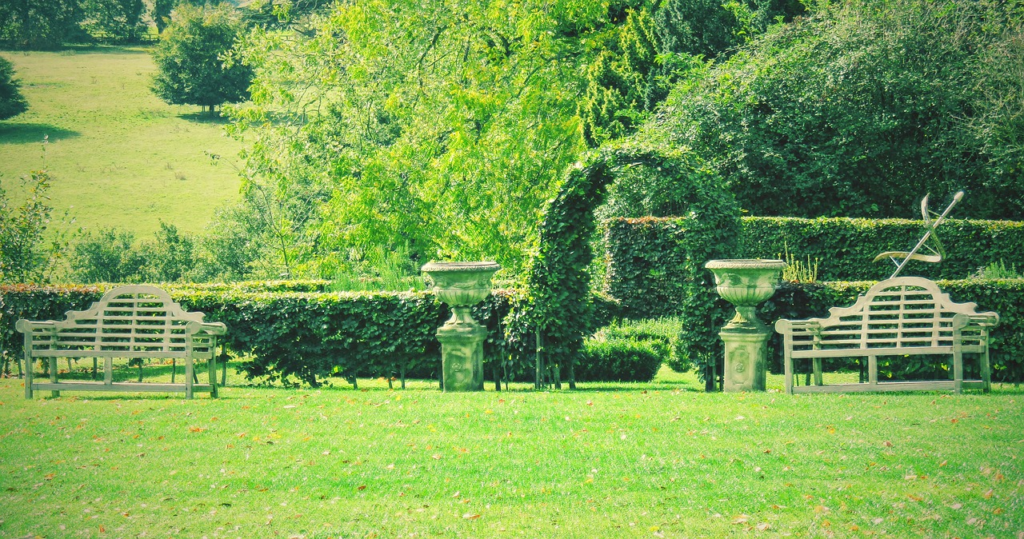Landscaping is a dynamic art that fuses nature and design, creating outdoor spaces that reflect cultural influences, historical contexts, and personal aesthetics. Depending on your own personal background and preferences to the location of your home, you can have anything from lush tropical escapes to serene Japanese retreats. To provide some examples, let’s delve into the world of landscaping and uncover the essence of some of the most prominent styles.

Tropical
History and Influences: Tropical landscaping finds its origins in the lush regions near the equator, such as Southeast Asia, Central and South America, and parts of Africa. The style developed as a response to the abundant biodiversity and vibrant climate found in these areas. European explorers and colonialists played a significant role in introducing tropical plants to other parts of the world. The colonial period saw the exchange of flora between the Old World and the tropics, resulting in the creation of botanic gardens to showcase these exotic specimens.
Benefits: The tropical landscaping style offers a year-round burst of colors and an immersive experience reminiscent of vacation paradises. This style provides a sense of escapism, allowing homeowners to feel surrounded by lush greenery and vibrant blooms even in temperate climates. Additionally, the dense vegetation offers shade and can help create a microclimate that reduces heat in urban environments.
Signature Features: Tropical landscaping is characterized by its dense foliage, bold and contrasting colors, and a wide array of exotic plants. Key signature features include the use of palm trees, ferns, orchids, and vibrant tropical flowers. The integration of water features like ponds, waterfalls, and fountains adds to the sense of a tropical oasis. Bold and textured foliage, such as large leaves and interesting plant shapes, creates a lush and vibrant ambiance.

Japanese Garden
History and Influences: Japanese garden landscaping finds its roots in Zen Buddhism and Shinto traditions, dating back to ancient Japan. These gardens were designed as places for meditation, contemplation, and spiritual reflection. The art of Japanese garden design was greatly influenced by Chinese garden aesthetics and philosophy, leading to the creation of distinct Japanese styles. Zen gardens (dry rock gardens) and stroll gardens (walking gardens) are two notable types that emerged over centuries.
Benefits: Japanese garden landscaping offers a harmonious and meditative outdoor space that encourages relaxation and mindfulness. This style provides a connection to nature and a sense of tranquility. The careful design and arrangement of elements contribute to a serene atmosphere that can alleviate stress and promote mental well-being.
Signature Features: Japanese garden landscaping is characterized by its minimalist and balanced design, often incorporating symbolic elements. Zen gardens feature raked gravel or sand to represent water and islands, with carefully placed rocks representing mountains. Stroll gardens include elements like bridges, lanterns, and stepping stones, leading visitors on a journey through the garden’s various vignettes. Pruned trees and shrubs, such as bonsai and cloud-pruned pines, add to the meticulous aesthetics.

Prairie
History and Influences: Prairie landscaping takes inspiration from the vast grasslands that once covered the American Midwest. This style developed as a response to the desire to recreate the beauty of native grasses and wildflowers. The prairie ecosystem was integral to the livelihood of Indigenous communities and later influenced pioneers’ perspectives on land and agriculture. The prairie movement gained momentum in the 20th century, promoting the conservation and appreciation of these unique landscapes.
Benefits: Prairie landscaping offers a connection to the natural heritage of a region and contributes to the preservation of native plant species. This style requires minimal water once established, making it an environmentally conscious choice in water-scarce areas. The diversity of native plants encourages pollinators and supports local wildlife, contributing to a balanced ecosystem.
Signature Features: Prairie landscaping is characterized by its use of native grasses and wildflowers, which create a tapestry of colors and textures. Tall grasses like switchgrass and big bluestem, along with native blooms such as coneflowers and black-eyed Susans, are staples of this style. The landscape often features undulating waves of grass, replicating the movement of prairie winds. Seed heads and dried foliage are embraced, adding interest and ecological value to the landscape.

Woodland
History and Influences: Woodland landscaping draws inspiration from the serenity and natural beauty of wooded areas. This style developed as a response to the desire to create outdoor spaces that replicate the calm and organic environment of forests. The English countryside, with its enchanting woodlands, had a significant influence on the development of woodland landscaping. The style gained popularity in the 19th century as an alternative to formal gardens, emphasizing a more relaxed and natural approach to landscaping.
Benefits: Woodland landscaping offers a serene and peaceful atmosphere, creating a haven for homeowners seeking to escape the hustle and bustle of urban life. By using native plants, this style encourages biodiversity and supports local wildlife, contributing to a healthier ecosystem. The use of shade-loving plants and trees can also help reduce energy costs by providing natural cooling.
Signature Features: The hallmark of woodland landscaping is its emphasis on native plants, creating a harmonious blend between the cultivated and the wild. This style often features shade-loving plants like ferns, hostas, and woodland wildflowers. The use of natural materials, such as stone or wood for pathways, retaining walls, and accents, enhances the organic feel of the landscape. Dappled sunlight filtering through the canopy, along with the incorporation of fallen leaves and mulch, adds to the woodland ambiance.

Desert
History and Influences: Desert landscaping was born out of the necessity to adapt to arid and water-scarce environments. This style developed as a response to the challenges posed by desert climates, where water conservation is paramount. The earliest desert landscapes can be traced back to ancient civilizations like the Egyptians and Persians, who utilized ingenious irrigation systems to cultivate oases in arid regions. Modern desert landscaping gained popularity in the mid-20th century as an environmentally friendly and sustainable approach to gardening.
Benefits: Desert landscaping provides an aesthetically striking outdoor space that requires minimal water and maintenance. This style is particularly suitable for regions with limited water resources, contributing to water conservation efforts. By incorporating drought-resistant plants like succulents and cacti, desert landscapes can thrive in even the harshest conditions, making them a practical and environmentally conscious choice.
Signature Features: The hallmark of desert landscaping lies in its use of succulents, cacti, and other water-efficient plants. Rocks and gravel are often employed to mimic the natural desert terrain, creating a visually appealing and low-maintenance landscape. Signature features include the sculptural shapes of cacti, the textural contrast between smooth stones and spiky plants, and the incorporation of dry riverbeds or sand to evoke the feeling of a desert oasis.

Spanish
History and Influences: Spanish landscaping draws from the diverse cultural influences of Spain, including Moorish, Mediterranean, and colonial elements. The Moors, who occupied parts of Spain for centuries, left a lasting impact on garden design through their ornate tilework, water features, and geometric patterns. The Mediterranean climate of Spain has also played a significant role in shaping the style, with its emphasis on drought-resistant plants and outdoor living.
Benefits: Spanish landscaping offers a vibrant and inviting outdoor space that captures the warmth of the Mediterranean. The fusion of cultural influences creates a unique and visually rich environment. This style encourages outdoor gatherings and leisure, making it ideal for creating functional and aesthetically pleasing spaces.
Signature Features: Spanish landscaping is characterized by its vibrant color palette, intricate tilework, and a blend of structured and organic elements. Terracotta tiles are often used for walkways, patios, and accents, reflecting the Mediterranean tradition. Courtyards, often featuring central fountains, create inviting gathering spaces. Ornamental ironwork, pergolas covered with climbing vines, and citrus trees contribute to the rustic and charming ambiance.

English Garden
History and Influences: English garden landscaping emerged in the 18th century as a departure from the formal and structured garden designs of earlier periods. This style developed in response to a growing appreciation for nature and the picturesque landscape. The romantic movement, which celebrated the beauty of the untamed countryside, heavily influenced the English garden style. The works of influential landscape designers like Capability Brown and Gertrude Jekyll played a significant role in shaping its evolution.
Benefits: English garden landscaping offers a serene and romantic outdoor space that seamlessly blends structured elements with the natural environment. This style encourages relaxation, recreation, and a connection to nature. The emphasis on perennials and native plants promotes sustainability and requires less effort to maintain than traditional formal gardens.
Signature Features: English garden landscaping is characterized by its informal layout, winding pathways, and diverse plant palette. Herbaceous borders filled with perennial flowers create a riot of colors throughout the seasons. The use of ornamental elements like arbors, trellises, and garden benches enhances the charm and functionality of the space. Ponds, streams, and fountains contribute to the soothing sounds of flowing water, while mature trees provide shade and structure.

Tuscan
History and Influences: Tuscan landscaping takes its cues from the rustic charm and timeless beauty of the Italian countryside, particularly the region of Tuscany. This style is deeply rooted in the agricultural traditions of the area, where landscapes often feature vineyards, olive groves, and simple yet elegant gardens. The Tuscan style draws from the rich history of Italy and the region’s agricultural heritage.
Benefits: Tuscan landscaping offers a warm and inviting outdoor space that captures the essence of Mediterranean living. This style encourages outdoor living and a connection to the land. By incorporating native plants and sustainable practices, Tuscan landscapes can be environmentally friendly and low-maintenance.
Signature Features: The hallmark of Tuscan landscaping lies in its earthy tones, natural materials, and a mix of elegant and rustic elements. Olive trees, vine-covered pergolas, and fragrant herbs like rosemary and lavender are essential features. Terracotta pots, stone walls, and gravel pathways evoke the charm of rural Italy. The integration of outdoor seating areas and al fresco dining spaces encourages relaxation and socializing.

French Garden
History and Influences: French landscaping has its origins in the formal gardens of French châteaux and palaces, particularly during the 17th and 18th centuries. The style was heavily influenced by Renaissance Italy and later evolved under the guidance of André Le Nôtre, who designed the iconic gardens of Versailles. The French style emphasizes symmetry, grandeur, and a sense of order, reflecting the aristocratic society’s pursuit of elegance and opulence.
Benefits: French landscaping offers an air of sophistication and elegance, transforming outdoor spaces into refined works of art. The symmetry and meticulously trimmed hedges create a sense of order and structure. This style also allows homeowners to pay homage to historical aesthetics and immerse themselves in a regal atmosphere.
Signature Features: The hallmark of French landscaping lies in its formal layout, geometric shapes, and precisely manicured elements. Parterres, or intricate patterns created by hedges or plantings, are a quintessential feature. Symmetrical pathways, reflecting pools, and fountains are common focal points that evoke a sense of grandeur. Sculptures and topiaries are often used to add visual interest and a touch of artistic flair.
Conclusion
Landscaping styles are as varied as the people who reside in them. They are a reflection of cultural heritage, environmental factors, and personal preferences as well as extensions of the home and the environment that surrounds it. From the lushness of tropical paradises to the minimalism of Japanese retreats, each style offers a unique experience and benefits that cater to a diverse range of tastes and needs. By understanding the historical roots and characteristics of these styles, individuals can embark on a journey to create their own outdoor haven that resonates with their vision and lifestyle.
Ready to embark on your landscape journey? Find out more about digital landscape design and how we can help you bring your landscape style to life!
